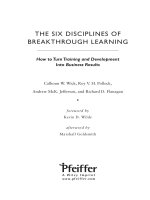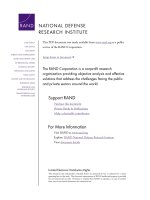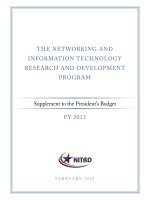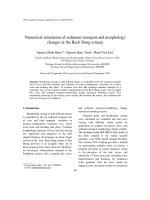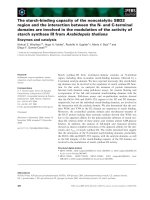the improvement of the training and development program at bitis company in vietnam
Bạn đang xem bản rút gọn của tài liệu. Xem và tải ngay bản đầy đủ của tài liệu tại đây (236.84 KB, 23 trang )
ABSTRACT OF DOCTORAL DISSERTATION
Research title:
THE IMPROVEMENT OF THE TRAINING AND DEVELOPMENT PROGRAM AT
BITIS COMPANY IN VIETNAM
Scientific Superior: Dr. Joanna Paula A. Ellaga
Ph.D. Candidate: Pham Do Dung
Viet Nam, July, 2013
Thai Nguyen University
Socialist Republic of Vietnam
Southern Luzon State University
Republic of Philippines
1
ACKNOWLEDGMENT
In grateful recognition and sincerest thanks for the encouragement, guidance and unselfish
sharing of their knowledge, time, effort and skills, and for the untiring motivation that leads to
the completion of this study, the Researcher acknowledges the following:
DR. CECILIA N. GASCON, Ph. D., President of the Southern Luzon State University in the
Republic of the Philippines, for her untiring effort and belief that this collaboration is possible
thus enabling us to pursue the DBA degree;
DR. NGUYEN THANH HAI, Vice Director of the International Training Center Thai Nguyen
University of the Socialist Republic of Vietnam, for his enormous pursuit to provide the
Vietnamese people an opportunity to grow through education;
DR. JOANNA PAULA A.ELLAGA for his selfless guidance and assistance thereby making
this paper a scholarly work;
MANAGERS and EMPLOYEES of Biti’s company, my Respondents, for their patience and
cooperation in answering the questionnaire and for other data given;
MY FAMILY and FRIENDS and to all who have contributed to make this study a success.
2
CHAPTER I: INTRODUCTION
1.1 The significance of study
People are the factors that constitute the organization, operation and determine the success or
failure of the organization. This is a valuable asset that every organization should know to take
advantage and develop. Furthermore, in integration of global economy, the training and
development of human resources is considered as a vital task for every organization because
strong human resources is the prerequisite to compete and survive in today's competitive
environment. Therefore, the improvement of training quality takes an important part in
development strategy
1.2 Background of the Study
In fact, Bitis as well as other Vietnamese companies, especially the large one have invested in
human resource development but it has not yet become strategic objectives of the business.
The recruitment, employment and training new employees is executed only in a short time yet
long-term goals. Many businesses have to face with the continuous jumping labour, especially
during economic instability. Meanwhile, training and development of human resources are
principally important since the majority of Vietnam's labor lack of knowledge and skills by the
education system and professional training did not meet the requirements business
BITIS have faced a difficulty regarding quality of worker, the lack of high skilled workers is
another weakness point of BITIS. That is the results of low level professional in recruiting
human resources for company. Moreover, lower awareness and less responsible made by a
small part of labor forces is still adverse impacting on company development.
Therefore, I have selected topics: “THE IMPROVEMENT OF THE TRAINING AND
DEVELOPMENT PROGRAM AT BITIS COMPANY” for my research. With a desire to
make a small contribution to improving the quality of human resources at the company Bitis.
1.3 Aims of Study
+ To evaluate the factors influence the training process at Bitis company
+ To recommend a best practice strategy for prevention of the negative influence for training
and develop human resource in organisation.
+ To outline solutions for the process to improve the training and develop human resource
at Bitis company.
1.4 Objectives of Study
1. To know the respondent’s profile in terms of the following
3
1.1 Company – respondent
1.1.1 Historical background
1.1.2 Organization’s frame work
1.1.2 Strategies
1.1.3 Human resources and development
1.2 Worker – respondent
1.2.1 Age
1.2.2 Gender
1.2.3 Length of service
1.2.4 Department
2. To determine the worker’s perception on how the company conducts training and
development program in terms of the following aspects
2.1 Policies and procedures
2.2 Awareness of employees on training process
2.3 Attendance to a formal training
2.4 Training method
2.5 Motivation to attend a training
2.6 Usefulness of the training
2.7 Gains acquired from the training
2.8 Applicability of training to specific job/tasks
2.9 Manager’s role in the training process
2.10 Influencing factors in the training process
2.11 Commitment to attend trainings
2.12 Suggestions to improved the training process
3. To design an improved training and development program for the company
1.5 Scope and limitations of Research
The study concentrated on one organisation only, Bitis company. This was due to the fact that
the author was unable to gain access to employees at any other organisation. The study was
also limited to research in one geography area, Hanoi.
4
CHAPTER II: REVIEW OF RELATED LITERATURE
2.1 The importance of training and development
Training and Development helps in optimizing the utilization of human resource that further
helps the employee to achieve the organizational goals as well as their individual goals.
Training and Development helps in increasing the job knowledge and skills of employees at
each level. It helps to expand the horizons of human intellect and an overall personality of the
employees.
2.2 Training methods
There are many training methods and new methods or variations are constantly being added.
The purpose of this section is not to try to list them all. Instead the focus will be on the top ten
training methods used in business today as reported by Lakewood Research and Training
Magazine [ Joinson, C., p. 55].
These top ten, listed in order from highest to lowest use, are as follows: videotapes, lectures,
one-on-one instruction, role plays, games/simulation, case studies, slides, computer-based
training, audio tapes, and films.
2.3 The factors influence the training
In organizations where a management training centre exists, for example, the training
department’s contribution is usually valued. Introducing such a centre involves a good deal of
initial research and evaluation and the financial commitments involved discourage the
management from taking lightly the decision to provide it. Moreover, if they are prepared to
make such an investment, the decision may be reasonably interpreted as an acceptance that the
training department is sufficiently competent to assume responsibility for all aspects of
management training.
The impact of government legislation on training has been considerable, in particular since the
year 2008 to now, the technical, vocational education and training in Vietnam is under the
administration of the two relevant ministries namely ministry of Education and Training
(MOET) and Ministry of Labour, Invalids and Social Affairs (MOLISA). MOET is responsible
for professional secondary Education and MOLISA is responsible for vocational training.
2.4 The brief overview of the steps of the training process follows: Identify needs,
evaluate needs, select courses, develop courses, determine workload, recruit trainers, identify
location and resources, finalize budget, finalize training plan, prepare courses, deliver courses,
validate training, evaluate training, revise courses
5
CHAPTER III: RESEARCH METHODOLOGY
3.1 Research design
In this research, four questions in section A are designed as an open question and 12
quantitative questions in section B are half-closed question, using both quantitative and
qualitative. These questions have been sent to Bitis for pilot study. They are seemed to have
good evaluation, easy to answer workers, less time consuming and respondent can add
comments if necessary
3.2 Research tool
The questionnaire was split into two sections, A and B. Section A was designed to ask
employees which group they belong to. Section B was designed to investigate the training
process, and evaluate the effective of training process at Bitis company and consisted of open
questions giving the respondent the opportunity to include any opinions or recommendations
regarding how Bitis company could improve their the training process for employees.
3.3 Sampling method
The researcher employed a probability, simple random sampling technique. This allowed the
researcher to obtain a straightforward sampling frame of all of the people in Bitis population.
Questionnaires were sent in post and distributed by the Administration department.
3.4 Research technique
The questionnaire consist of both open and close questions. Closed questions are quick and
easy to answer, they require no writing, quantification is straightforward and respondents are
offered a choice of alternative replies. Open questions allow participants to define and describe
a situation or event.
3.5 The Pilot Study
In order to increase the validity of the questionnaire a pilot study was carried out initially. Pilot
questionnaires were sent to two employees at Bitis company, inviting them to constructively
criticise the questionnaire. The aim of the pilot study was to refine the questionnaire so that
respondents would have no problems in recording the data.
3.6 Procedure
Following the amendments made from the results of the pilot study, the finalised
questionnaires were distributed along with a cover letter for respondents outlining the aims of
the study, assurances of confidentiality and informing the individual of the right to withdraw
from the study at any time.
6
3.7 Data analysis
Author used excel to percentage calculations to establish trends in the data obtained and data
was presented in the form of pie charts. After that, using relative theory to analysis.
7
CHAPTER IV: RESULTS AND DISCUSSION
4.1 The background of Bitis company
4.1.1 Historical background
BITIS, a short name of the BINH TIEN Consumption Goods Production Limited Company.
Established in 1982, with more than 30 years experiences manufacturing and exporting shoes,
BITIS is known as one of top 10 biggest footwear companies in Vietnam. BITIS is also the
most famous and popular brand name in not only home country but also in many other nations
in the world. Nowadays, BITIS has 5000 different types of products, from footwear using at
home to senior fashionable products. Each type of products has various different designs
providing more options for customers.
4.1.2 Organization’s framework
BITIS have two braches namely Biti’s Western Branch and Biti’s Southern Branch and four
trade centers including Biti’s Highland Trade Center, Biti’s Northern Trade Center, Biti’s Lao
Cai Trade Center and Da Nang Business Center. Besides that BITIS have 4500 agents covering
every commune in the whole country and some other regions in the world. Around 9000
workers are employed in BITIS, and 10% of its have bachelor and master degree.
4.1.3 Bitis strategies
BITIS has built a number of specific strategies for its development. The first strategy is
enhanced the position of company though increasing capital, investing in modern technology,
improving management and applying quality assurance. Secondly, BITIS has increased their
direct interactions with potential overseas clients in order to widen its market. Moreover,
BITIS has provided a competitive environment for workers to develop their potential abilities
to company development. Finally, building customers’ trust is another core of the BITIS
strategy.
4.1.4 Human Resources Management and Development
Investing in human resources development is also a basic policy applying by this company.
Employees benefit from improved knowledge and skills and remain with the company longer.
A number of programs are in place to support workers’ long-term commitment to BITIS and to
encourage continuing education and skills upgrading, including leadership, management and
professional development, as well as quality, occupational health and safety and environmental
standards.
4.2 Worker-respondent
8
Section A
PIE CHART ILLUSTRATING THE AGE OF EMPLOYEES AT
BITIS COMPANY
45%
30%
20%
5%
Under 25
From 26 to 40
From 41 to 50
From 51 to 60
With pie chart above, the highest rate of age is the employees who are under 25 age,occupy
45%, in contrast, the lowest rate of age who are from 51-60 is only 5%. Meanwhile, the rate
of employees who are from 26-40 and the rate of those who are 41-50 is 30% and 20%
respectively.
PIE CHART ILLUSTRATING THE NUMBER OF MALE AND
FEMALE EMPLOYEES AT BITIS COMPANY
40%
60%
Male
Female
The result obtained revealed that 60% of respondents answered ‘Female’ , meanwhile 40% of
respondents answered ‘Male’. It is disproportionate because Bitis company’ characteristic are
producing and selling shoes, in addition female who has good communication ability and
quickly to introduce to the customer about the feature of products. Likewise, according to
East’s custom the characteristic of women is pleasant, gentle, so the female is required more
than male employees.
9
PIE CHART ILLUSTRATING THE EMPLOYEE'S LENGTH OF
SERVICE AT BITIS COMPANY
15%
25%
35%
25%
Less than 1 year
Between 1 to 2 years
Between 2 to 3 years
More than 3 years
With pie chart above, we see that the highest rate of length of service at Bitis company is the
employees who work from 2-3 years,occupy 35%, On the contrary, the lowest rate of length of
service at Bitis company is the employees who work less than 1 years is only 15%. Following
the rate of employees who work from 1 to 2 years and the rate of those who work more than 3
years are similar respectively achieve 25 %. This shows that the labor force is not stable .
PIE CHART ILLUSTRATING THE PERCENTAGE OF
EMPLOYEES WORK IN DEPARTMENTS
60%
18%
12%
4%
6%
Manufacturing department
Selling department
Marketing department
Financial department
Security department
With pie chart above, we see that the highest rate of department is the employees who work in
manufacturing department, occupy 60%, in turn the selling, marketing and financial
department is 18%, 12%, and 4% respectively, finally security department is only 6%. This
suggests that indirect labor force working in departments is large proportion. This is quite
common in Vietnam enterprises, demonstrating the level of corporate management Vietnam is
still limited.
Section B
10
PIE CHART ILLUSTRATING THE EXTENT TO WHICH
EMPLOYEES BELIEVE THAT THERE ARE CLEAR PLANS AND
POLICIES IN TRAINING AND DEVELOP HUMAN RESOURCE
AT BITIS COMPANY
65%
35%
Yes
No
The results revealed that 65% of the respondents answered ‘ Yes, I think that company has
clear policies and procedures in training course’. 35% stated ‘No’ those respondents who
answered ‘ No’ commented on contact with their manager but no specific examples were
given. The policy of training and development is not very clear.
PIE CHART ILLUSTRATING THE EXTENT TO WHICH BITIS
EMPLOYEES THINK ABOUT THE TRAINING PROCESS THAT
THEY RECEIVED
65%
25%
10%
Good
Normal
Not Useful
The respondents who answered ‘ Good’ amounted to 65% of the sample population it
implicate that the knowledge ,skill the employees are learned are new and useful for them, with
enthusiasm of teachers.
With regard to 25% stated ‘ Normal’ and 10% answered ’Not Useful’. The reason for these
come from the knowledge that employees received are only theory, it is not suitable with their
job. And the time for training allocated was not enough for them.
These objects are often indirect employees in the department. Subjects were typically trained at
colleges and universities. When they join the training course without the knowledge or without
a new communication method that only about theory, they feel un useful, even take time
11
PIE CHART ILLUSTRATING THE NUMBER OF EMPLOYEES
HAVE BEEN ATTENDED A FORMAL TRAINING WHILST
WORKING FOR BITIS COMPANY
55%
45%
Yes
No
Results obtained revealed that 55% of the respondents answered ‘ Yes’. Common themes in
answers given were that the respondent had been attended in training course which were
organised by the company or the company send them to the short courses. 45% of the
respondents answered ‘ No’. it means that they do not attend the training courses, before,
because they are new employees or they do not attend the courses with the reason from them.
PIE CHART ILLUSTRATING THE EXTENT TO WHICH
METHODS ARE USED IN THE TRAINING PROCESS
40%
40%
20%
on the job training
lecture, seminar and
video
games,case studies,
role plays,other methods
With above percentage we can divide into three groups, group one is on-the-job training,
group two include in lecture, seminar, and videos and group three consist of other methods.
The methods used to train employees were on-the job training (40 per cent), lecture seminar
and video (40 percent ) and games case studies, role plays, so on (20 per cent).
The traditional methods were majority if company invite trainers teach employees at
company and it was usually 1 to 2 days so there is little time for training employees.
Meanwhile, employees attended training courses at centre training, there were facility with
modern equipment so they were taught by many variety including lectures, seminars, videos,
12
games case studies, role plays,and one-on-one instruction which were interested much by
employees because it is a way to apply the knowledge from theory to specific job quickly.
PIE CHART ILLUSTRATING THE PERCENTAGE OF
EMPLOYEES FEEL MOTIVATION TO ATTEND THE TRAINING
COURSE
75%
25%
Yes
No
Results obtained revealed that 75% of the respondents who stated that ‘Yes I feel motivated
to attend training courses’ and 25 per cent who answer that ‘No’.
In relation to those who answered 25 per cent saying that ‘No I do not feel motivated to attend
training courses because some employees did not see learning as a high priority, they 'had not
got around to it'. This was particularly marked for those in low skilled jobs such as security
department or employees who attended training course, before. In respect of 75% of the
respondents answered ‘Yes’ because they want to update latest knowledge, improve their
work performance and to keep up to date in their specialist fields.
PIE CHART ILLUSTRATING THE EXTENT TO WHICH
EMPLOYEES KNOW THE TRAINING PROCESS AT BITIS
COMPANY
30%
70%
Yes
No
Result obtained revealed that 70% of respondent stated ‘ No I don’t know the training process
at Bitis company’ , 30% of respondent answered’ Yes’.
13
70% of respondent stated ‘ No’ because when they were informed from manager, it was
depend on the course training relate to their job if it had involved they would have registered
with their chief, then the chief analyzed the strengths, weaknesses of employees and make a
report to hand in leaders of company.
30% of respondent stated ‘Yes’ it revealed that each chief of department make a report about
the demand for training employees and make a report, send to leaders, the leaders who
received the report will rely on the plan of financial and select the department that they think it
is likely necessary more than the rest of departments.
PIE CHART ILLUSTRATING WHAT BITIS'S EMPLOYEES
RECEIVED IN THE TRAINING COURSE
30%
60%
10%
Knowledge
Skills
Attitude
30% of respondent stated ‘Knowledge’ and 60% of respondent answered ‘Skills’ meanwhile
10% of respondent stated ‘The attitude’ was limited. The persons who answered ‘Skills’
implicate that the majority amount of employees were attended training course are workers,
they are recruited by Bitis company after they only finish the secondary school or had
graduated vocational school.
30% of respondent stated ‘knowledge’ revealed that beside their basic skills they need to have
more knowledge to meet the require of customer who are demanding high- quality products
and services especially in the fierce competition environment nowadays. Examples: In selling
department, the employees must learn the knowledge of the shop’s merchandise such as
quality, physical characteristics.
14
PIE CHART ILLUSTRATING THE TRANSFER TRAINING OF
EMPLOYEES AT BITIS COMPANY
65%
25%
10%
Yes
Not much
No
65% of respondent stated ‘Yes’ they can apply the knowledge and skills to the job reveal that
the knowledge could apply to the job and improve their performance, 25% of respondent
answered ‘Not much’ because they say it is not suitable for their current job, they do not
enough facility to apply or they would like perhaps they mean they don’t want to apply or
share it with others, do not share with colleagues and 10% of respondent stated ‘Not’ has
similar answer. In addition there were some other reason.
PIE CHART ILLUSTRATING WHETHER EMPLOYEES
BELIEVED THAT MANAGER MOTIVATE THE TRAINING
PROCESS
60%
30%
10%
Yes
Less Know
No
60% of respondent stated ‘ Yes the manager motivate for employees attend training’. 30% of
respondent stated uncertain and 10% of respondent answered’ No’. it reveals that they are
new employees they do not received the information from the leader of company or when they
only see the manager requires them to make sure every operates are in order and on time,
avoid accident and are effectively.
15
PIE CHART ILLUSTRATING THE FACTORS INFLUENCE THE
TRAINING PROCESS AT BITIS COMPANY
40%
40%
20%
Time
Fund
Other reasons
The results revealed that 40% of respondent stated time is influence the training process, 40%
of respondent answered the fund is affect the training process and 20% of respondent stated
that other reasons.
Common themes in answers given by respondents who answered time is influence the training
process were that working such long hours or had so stressful a workload that they did not
have the time to take up a course. In addition, they do not feel enough health or tired after hard
working all day, so they are not interested in learning.
PIE CHART ILLUSTRATING THE COMMITMENT BETWEEN
EMPLOYEES AND BITIS COMPANY
25%
45%
30%
Yes
No
Do not know
The result obtained revealed that 25% of respondent stated ‘Yes I have to make commitment
with Bitis company when I attend learning course’. 45% of respondent answered ‘No’ and
30% of respondent stated ‘Do not know’.
Obviously, we see that the commitment between Bitis company and employees was not much
meanwhile the total of fees for leaning course include long time or short time were paid by
company so Bitis company need to increase the commitment with employees because
16
Commitment of employees can be an important instrument for improving the performance of
organizations.
PIE CHART ILLUSTRATING THE EMPLOYEE'S IDEAS FOR
IMPROVING THE TRAINING PROCESS AT BITIS COMPANY
65%
20%
15%
Time
Facility in working
enviornment
Others ideas
The result revealed that 65% of respondent stated Bitis company need to allocate suitable
time for training. The themes of given answered they need to be trained at the company or are
attended at training centre at the time job, so they could balance job-life, because after working
all day, they feel tired and they need to time to relax and look for their family .
20% of respondent stated Bitis company need to facility for them in working, they need to
make decide in their own, so this way, they could feel responsible for their job, from that they
could have creativity and apply their knowledge into job effectively.
15 % of respondent answered Bitis company need to increase notice the training plan for all of
employees, or promote the feedback to everyone could know their ability and from that there
is motivation to struggle in working.
17
CHAPTER V: SUMMARY, CONCLUSIONS AND RECOMMENDATIONS
5.1 Summary
The author believe that the aims and objectives of this study have been achieved.
Firstly: The author has collected and analyzed Bitis company overview on the fields of History
development, scale, strategy and human resource development company Bitis
Secondly: The author investigated and analyzed all the information about the employees in the
company: age, gender, duration of work in the company, employees in the department, the
investigation of cognitive of employees in the company in many ways for the research
objectives is to improve training and human resource development within the company.
For the purposes of the study: The author designed the questionnaire by asking many
questions, including open and closed, sent to the company through management then collected
through excel software for statistics and analysis on the chart.
From the analysis and evaluation in Chapter 4 the author makes conclusions and
recommendations to improve the training and development of the company Bitis.
5.2 Conclusions
Firstly, Bitis company manufacturing and selling shoes, with its characteristic, female workers
are more than male ones, there are near two third of total employees and majority operate in
producing department, with average employee’s age is twenty six.
Secondly, with regard to plan and policy for training and develop human resource, it is not
clear, not at all employees know, and many time it is uneven.
Thirdly, 45% of employees have been attended in training course, but it is short time with
skills for producing, (certainly sewing and mending), selling , marketing and financial.
Fourth, although the employees have motivation to attend training course, but sometimes the
knowledge they received is normal and not useful, is only theory and not reality.
Fifthly, the methods for training is still traditional ones. so Bitis company need to concentrate
on- the – job training, it is effective and quickly way to apply the skills and know ledges to the
job.
Sixth, time and fund are essential factors barrier the training course. To ensure the producing
on time and effective, Bitis company usually organise the training course out the job- time
(from 5 pm to 8 pm). Obviously with hard working at all day, employees feel tired and do not
motive to learn and certainly, it is not lead to effective result. And it is waste time and fund.
18
Seventh, the total of employees have made commitment with Bitis company is not much, only
have 25% of the employees, in addition, the number of employees who work under one years
leave Bitis company is 15%, so it is unstable in organise activity.
Finally, many ideas is need to create the working environment, the employees need to be
freedom and autonomy in their work, so it will built the comfortable and creative in working.
5.3 Recommendations
Resulting from the evaluation, analysis, and conclusions, Bitis board of management should
develop an improved training and development program for the company as follows
5.3.1 In respect of training policy
Bitis company need to increase notice the training plan for all of employees, or promote the
feedback to everyone could know their ability and from that there is motivation to struggle in
working. Everyone should be clear as how this will be carried out. The employees must be
involved in the planning, the progressing and the evaluation of his own training. The company
will encourage and provide some support for each person. There is also ideas revealed that
company need to send them more to study abroad, because when they are studied at broad,
they could update the latest knowledge, so it is the way to help company to develop quickly
and durable or company.
5.3.2 With respect of methods training
Company need to combine all of training methods, because each method has advantage and
disadvantage and use the form of training short- time and long – time together.
The training course should be organise in time-job or Bitis company could be organise
training course at the weekend and employees will be trained in turn so it is benefit for both of
employees and company.
Training courses to suit each learning objects, training should not lead to mass wasting and
time consuming. The design of the training program must be realistic, inspire learners, the
selection of teachers and teaching tool used is also a matter of concern.
With regard to each department company should have a suitable arrangement such as
marketing department where the employees could send to attend the centre training, meanwhile
the manufacturing department in which there are many workers so company should invite the
teacher into company.
5.3.3 With regard to training evaluation
There should be an effective system of review and evaluation including the on-going
monitoring of progress, a supporting appraisal system and the maintenance of suitable training
19
records. Evaluation should involve assessment by the trainers, line managers and supervisors
and the trainees. The review process should include identification of those areas to which
greater attention should be given in future training programmes.
Therefore, every week company should requires employees in each department to handle in
their results to chief of department who is responsible make statement to send to above
leaders. Subsequently, the employees will be received feedback, that enables them to know
their strengths, weaknesses and to fix their own deviations from performance standards.
Besides that company could know how much the transfer training that employees apply to
their job and the extent to which it contributes to improved organisational performance and
effectiveness and to the quality, job satisfaction and prospects of employees.
5.3.4 In respect of commitment
The training is only to be implemented successfully if there is a co-operation and commitment
of all member of employees. In addition, this is important since training can be abortive if
there is no commitment on the part of those being trained. Part of this commitment comes from
an understanding of what the training policy is all about, hence the need to explain it carefully
to everyone.
Likewise there is necessary to increase the commitment with employees when they begin
working at company about time, condition working, training, welfare. It make employees not
hesitate in leaving company , they could spend their effort and time on working from that
there will bring the benefits for company in long-term rather than short-term perspective.
5.3.5 With respect of working environment
Company should install the internal network by e-mail, it is a way to control the step in
working process, and people are given freedom, responsibility and considerable autonomy in
how the task is achieved.
With regard to employees usually work outside, transaction with customers such as marketing
department or sale department, to work effectively, company provide mobile phone for them to
keep information with company.
With regard to employee that is move to other department, such as from selling department to
marketing department, they need to re- train to know new procedure, job process and assign a
employees have responsibility to instruct them.
To everyone has more understanding together, company usually organise some meeting, party,
or picnic, encourage everyone join in an atmosphere of playfulness and a sense of fun,
20
affection, loyalty and community are developed, through that everyone could know better
each other such as family’s circumstance, custom and the needs or aspiration.
In addition, company could reward employees with personal gifts direct from the board of
directors after good performance. It is a way to express the thanks of company to the
employee’s contributions and hope that they will be here for long time.
As a result, Bitis company will be stable in operating and success for next years. Through
that, it will also good image of company for customers, supplier and other organization and
strengthen its position in the market.
5.4 Limitations of Research
The study concentrated on one organisation only, Bitis company. This was due to the fact that
the author was unable to gain access to employees at any other organisation. The study was
also limited to research in one geography area, Hanoi. This introduced regional bias and
consequently the sample is unrepresentative and generalisations to the wider population should
be taken with caution. Therefore, only further research in other organisations across a greater
geographical spread could prove or disprove the research findings.
The study concentrated on self-administered questionnaires so there may be flaws in
individual responses given in the questionnaires. Respondents may have conferred with their
colleagues before answering questions, may have lied or recollections may have been incorrect
or exaggerated.
5.5 Further Research
A suggestion for further research would be the training needs analysis in company, the
organisations investigated should cover a wide geographical spread to eliminate regional bias.
Alternative, future research could comprise of carrying out a comparison between
organisations that have organise training effectively in the same field or organisations which
are different industry sectors. Further research for shoe companies, even whole Vietnam
footwear industry.
21
BIBLIOGRAPHY
Aaron W. Hughey, Kenneth J. Mussnug.(2007). ‘Designing Effective Employee Training
Programmes’. [Online] In: Journal of Training for Quality. Volume 5 Number 2 . pp. 52-57.
Emerald Fulltext Service 2005.
Allan D.Pepper. (2007). Managing The Training & Development Function.(3
rd
). England.
Gower Publishing Company Limited.
Annual Report of Bitis Company (2012).
Bartel A. P. and Sicherman N. (2008) ‘Technological Change and The Skill Acquisition of
Young Workers’. Journal of Labour Economics, 16(4), 718-755.
Berry,J.K (2010)’ Linking management development to business strategies’. Training and
Development Journal, August, 20-22.
Burke, L.A, (2007) , "Improving Positive Transfer: A Test of Relapse Prevention Training on Transfer Outcomes",
Human Resource Development Quarterly, 8, 2, 115-28.
Cross, R.L. and Funk F. L. (2007) ‘ Leveraging Intellect in a small business’.
Daines, J., Graham, B.,( 2008) Adult Learning: Adult Teaching, Department of Adult
Education, University of Nottingham, Nottingham.
Economic, (2012) ‘Training in VietNam’ , June, 14-20.
Hesketh, B, (2007), "Dilemmas in training for transfer and retention", Applied Psychology: An International
Review, 46, 4, 317-86.
Investment, (2010), ‘Human Resource in VietNam’, April, 12-16.
Jankowicz, A.D. (2010), Business Research Projects. (3
rd
Edition). London. Thomson
Learning
Labour, (2011) ‘The Technology Transfer in Vietnam ’ , November, 14- 18.
Martocchio J. J . and Baldwin. T.T. (2007), ‘The Evolution of Strategic Organisational
Training’. Research in Personnel and Human Resources Management, 15,1-46.
Noe, R.A, Schmitt, N, (2008), "The influence of trainee attitudes on training effectiveness: test
of a model", Personnel Psychology, 39, 497-523.
Olsen, J.H. Jr, (2008), "The evaluation and enhancement of training transfer", International
Journal of Training and Development, 2, 1, 61-75.
Robinson, T., Clemson, B., Keating, C., (2007), "Development of High Performance
Organizational Learning Units", The Learning Organization, 4, 5, 228-34.
22
Seyler, D.L, Holton, E.F. III, Bates, R.A, Burnett, M.F, Carvalho, M.A, (2008), "Factors
Affecting Motivation to Transfer Training", International Journal of Training and
Development, 2, 1, 2-16.
Toffler, A. (2010) Powershift: Knowledge, Wealth and Violence at the Edge of the 21
st
Century, Bantam, New York.
Ulrich, D.(2008). Human Resource Champions. The Next Agenda for Adding Value and
Delivering Results, Boston, Mass: Havard Business School Press,pp88.

